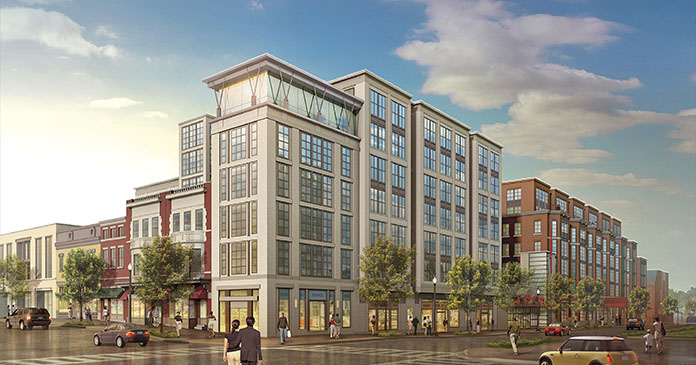
Butz and Lamb plan to own the assets they acquire and build with their investment partners for a long time, in the neighborhood of seven to 10 years. “That’s not to say we won’t do some merchant building with some equity partners, but, generally speaking, we’re going to try to build a portfolio to own,” he said of the young company that will focus on smart growth and environmentally responsible development.
And they plan to build on skills they honed at JPI, including the ability to endure long entitlement periods with patience, which JAG’s founders proved, once again, pays off, when they celebrated the emerging company’s first development start in August. President and CEO Butz and Executive VP and Partner Lamb worked for five years to obtain permits for the 230-unit, luxury apartment community in that just broke ground in Pennsylvania.
“It’s been a long time in the making and we’re very excited to have it under construction,” Butz said, shortly after the $40 million Jefferson at West Goshen got underway on 11 acres, once home to a brewery owned by the Spazziano family in West Chester.
Their perseverance also was tested when the long-planned launch of their own apartment development, investment and management firm—modeled in the image of JPI, the company of which it then was the Eastern division—was derailed for a year by the economy’s downturn early in 2008.
In 2006, Frank Miller, JPI’s late chairman and CEO and one of the company’s four founders, offered Butz the opportunity to buy JPI East, the division he grew from the office in the Mid-Atlantic he took over in 1997, when JPI was nine years old.
Originally JPI East
Thirteen years ago, the merchant builder consisted of nine regions—the Northeast, Mid-Atlantic, Southeast, Central, Colorado, Southwest and California—and, over years, Butz added to his responsibilities the Atlanta, Florida, Boston and New York offices and the company was consolidated into four divisions—JPI East, JPI West, JPI Central and the student housing component—along with a number of regions, he explained recently.
Prior to Miller’s death in 2007, a contract was executed for the sale of JPI East to Butz, who then was that division’s president and managing partner and Lamb was JPI Mid-Atlantic’s executive VP and regional managing partner.
With the help of JPI’s leaders, Butz was able to arrange funding for the deal. “They were going to provide seller financing, but with our relationship with GE Capital Real Estate, we received a commitment from General Electric to give us the same type of equity and pre-development investment that they had provided for JPI,” Butz recalled.
“That was in January of 2008—not that long ago—but soon thereafter, in the spring of 2008, the markets really fell apart and GE had to stop investing in real estate of that size. Obviously, it was a large platform opportunity with our new JPI East company,” he said, referring to the company-to-be’s original name.
Instead of his launching his own company, he stuck with JPI to assist in its downsizing, which was an appropriate response to market conditions at the time. The slimmed down version of JPI is alive and well in Dallas, with a portfolio of 10,000 apartments, many of which Lamb and Butz have retained an interest in.
JAG is born
Although Miller was gone, JPI’s founder Bobby Page and the other partners remained committed to honoring the contract that remained in limbo following GE’s investment retreat.
“They honored their commitment and, in June of ’09, we were able to complete that transaction and we bought JPI East and changed the name to Jefferson Apartment Group (JAG), which obviously refers to the name of all the projects we’ve built over the years and which we retained to keep some continuity,” explained Butz, who ultimately found the investor he needed in Akridge, a 36-year-old, D.C.-based full-service commercial real estate firm, to help him buy JPI East.
He and Lamb spent the early days of their new-born company’s life pursuing equity relationships similar to their 10-year experience with GE at JPI, when GE invested in 75 percent of all JPI’s developments on the East Coast, where the partners acquired and/or developed 18,000 units, located in 10 states along the eastern edge of the country, valued at around $3 billion during their tenure with JPI.
“We liked that type of relationship,” Butz said of the GE Capital Real Estate involvement with JPI that predated Butz’ arrival at the company. GE invested in more than 40 JPI projects in Texas, Colorado, Florida and the Northeast, totaling $470 million by 1997.
In November of 2009, JAG closed on a strategic venture with the Boston-based Rockpoint Group, a global real estate investment management firm. The venture, focused on multifamily opportunities from D.C. through Boston, the Mid-Atlantic and the Northeast, expects to close its first development deal in November. “And, then, we have a number of other institutional equity relationships we’ve had over the years, like AEW with whom we just closed a deal in the Philadelphia area, which is a new development deal,” he said, referring to the West Goshen Township project, The Jefferson at West Goshen, one of the deals Butz and Lamb brought with them.
A deal grows in Philly
The deal grew out of a relationship then-JPI Development Manager Drew Chapman, now Jefferson Apartment Group’s director of development in Philadelphia, had with the property located in the area where he grew up.
“He knew the Spazziano family and probably, when he was over 21, of course, starting buying his beer there. So, we were able to get in contact with the family to buy the property as JPI and we took it through the entire zoning process and then later had the opportunity to take that deal with us to Jefferson Apartment Group,” said Butz.
The Jefferson at West Goshen is a four-story, wood-frame wrap around four stories of above-grade parking, with interior corridors, elevators, landscaped courtyards, a pool, fitness center, a cyber cafe and numerous other upscale amenities and finishes like granite counter tops, similar to those that are the hallmark of JPI’s upscale developments. The community is set on 12.8 acres of land in West Chester, about a mile from downtown West Goshen and 25 miles west of downtown Philadelphia in an area with high barriers to entry.
Wells Fargo is providing a standard three-year construction loan with two one-year extensions at 60 percent LTC for the $40 million development. JAG and AEW are committing the remaining 40 percent of the equity needed for the deal that is scheduled for completion in September of 2011.
“We did another project just down the street, Jefferson at Westtown, that did very well. It’s a good sub market between Philadelphia and Wilmington with a lot of employment up and down the 202 corridor,” said Butz. And, he continued, other than one project with around 150 units that delivered a year ago, there’s been no new apartment supply of any consequence in the corridor in about six years.
He and his team have learned through years of experience to endure the lengthy entitlement process in the Philadelphia area that keeps many developers away from the market. “Philadelphia’s a major city with more than five million people, but it’s not a growth market, even though it’s a coastal East Coast market. And part of the reason for that is it takes a long time to get these deals done and a fair amount of pre-development funding and that was our experience. We did several deals as JPI in Philly and we had one deal under contract for seven years to get it zoned. But, if you could get through that, they were also all profitable,” said Butz.
Development in Metro D.C.
In addition to the deal near Philadelphia, the new company’s leaders brought with them a project they won through an RFP process in Fairfax County, Md., that is in the pre-development stage and should start sometime next year. The Residences at Government Center will consist of 270 moderately-priced apartments, next door neighbor to the Fairfax government center on nine acres of land the county contributed to the project.
The community that will provide workforce housing in the Fair Oaks market is part of an initiative that is a top propriety of the county board of supervisors. The RFP process in which Butz and Lamb won the opportunity to build the four-story, wood-frame wrap around multi-level above-ground parking, sought a private developer to build a pedestrian- and commuter-friendly, moderately-priced apartment community that would be privately run, with the help of a public subsidy to keep the rents low.
Although the development is a luxury product, the units will be leased to households earning between 50 percent and 100 percent of area median income and will be the first 100 percent workforce housing development to be built in the county since its adoption of the workforce housing policy three years ago. Residences at Government Center is one of three projects JAG plans to start next year, totaling 812 units and representing $175 million of production.
Underway in 2010
This year’s development activities started with the demolition in August of the 50,000 sq. ft. beer distributorship building in West Chester to make way for construction of the West Goshen project. Architect Preston Partnership designed the community to include one-, two- and three-bedroom apartments that will average around 1,000 sq. ft. and rent for about $1.60/sq. ft.
That groundbreaking will be followed this year by a couple of other communities in the D.C. area, bringing this year’s total projected production to 665 units, with a total cost of around $180 million.
The 231-unit Jefferson14 at 14th Street and W Street is a venture with Perseus Realty and is expected to break ground around the beginning of November. Located on 1.3 acres, the property is next door to a YMCA building, which the developer will tear down and replace with a new structure, part of which will be given back to the YMCA. Butz expects the other 12,000 sq. ft. on the corner will house a restaurant.
“We have our equity committed by the Rockpoint Group and we’re in the final stages of putting together our construction debt and moving ahead toward closing,” Butz said of the luxury high-rise that will house ones and twos that will average 828 sq. ft.
Building beats buying
If he’d been asked at the beginning of the year what percentage of his new company’s business would be focused on acquisitions and how much on development, he would have said 75 percent would be acquisitions and 25 percent development. But, two things happened in the apartment market that have put development on JAG’s front burner, Butz explained.
“One is there has not been as much distress in the multifamily market as you find in office, retail and hotel market. So, apartment acquisitions have been very competitive and, with interest rates so low, the cap rates have also been fairly low. So, the market never got quite as weak as everybody who wanted to buy had hoped. And, because of our relationship with Rockpoint and our experience helping us with other institutional equity providers, we’ve been able to migrate back towards the development front,” he said.
So, the company’s leaders focused instead on tying up five good sites between their McClean, Va., headquarters and Boston, predominantly in D.C., which is probably the healthiest market on the East Coast. “We’ve done that and we’re still working on a site up in Metro New York—not Manhattan—and a second one in Philly and one in Metro Boston,” he said, explaining that, while the company’s footprint extends down through Florida and into Atlanta, the plan is to acquire existing multifamily properties in Florida and leave Atlanta alone for a while.
Rebuilding management
Jefferson Apartment Group’s model is to be a full-service apartment investment firm that provides construction, development and property management, as well as acquisitions, with the goal over the next few years to acquire or develop 5,000 units and to build a new management company.
Since JPI sold its management company to Greystar at the beginning of 2009, Butz and Lamb have managed the assets they have on the East Coast out of the several JPI offices that comprised JPI East. “So, we’ll be building our management company over the next 12 months. We’re just starting, but we have five properties to put into it over the next few months that we will announce a little later in the year, all in Metro D.C.,” he said, adding that purchase of a small management company or two to jump start that business is part of the plan.
Looking five years into the future, Butz said, “If we could have 8,000 units under management, 5,000 that we own, we’d be very excited. Similar to what we did at JPI, we’re going to limit the number of markets that we go into. We won’t go to secondary markets. We want to be a proven leader in the major markets on the East Coast,” he said.
Here comes the sun
He believes that the apartment sector finally has hit bottom. Construction prices are as low as they’re going to get and likely will stay flat for the next six months or so, but he doesn’t expect them to go any lower. Interest rates also are as low as they can get, he thinks, with LIBOR at 0.3 percent, construction debt is inexpensive and acquisition debt with the GSEs is available at very good rates.
“I think values should move up over the next five years,” he said. Looking back at the pattern of economic cycles over the past 75 years, it appears that we’re coming to the end of this recession and by the end of the year, we’ll be moving forward, Butz predicted.
And he sees only sunny skies ahead in JAG’s chosen regions. “We’re very fortunate to be in some of the best markets, like Washington, D.C., going forward, and we’re starting at great time. The economy has been very difficult for the last two years, as we all know. But, when you look out over the next three to five years, with low supply, a great renter demographic and lower homeownership rates, we’re pretty excited about being in the multifamily investment business,” the apartment veteran said.















